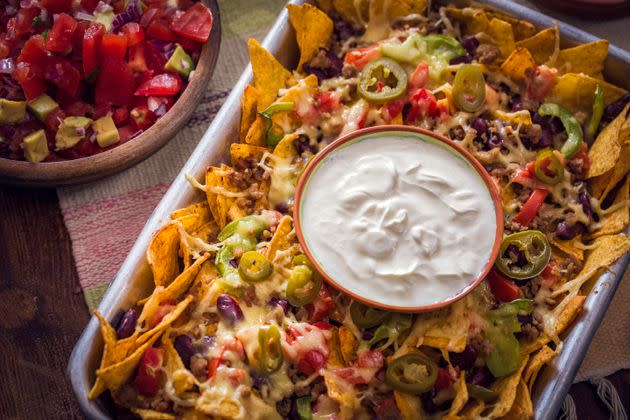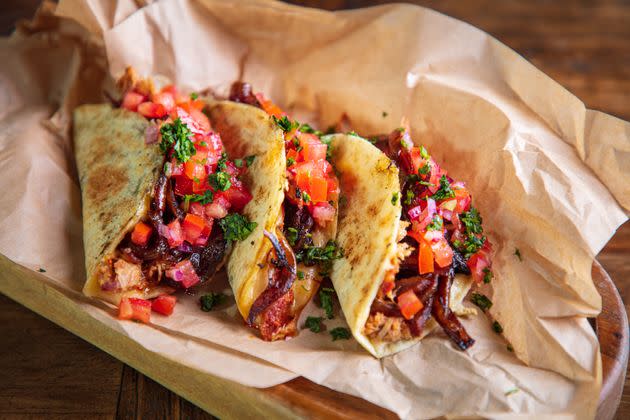6 Myths About Mexican Food That Mexican Chefs Want Americans To Stop Believing

If you have plans to eat at a Mexican restaurant for dinner in the States, you probably have a few expectations — complimentary baskets of golden tortilla chips and salsa, tacos, burritos, enchiladas and a whole section on the menu devoted to margaritas. Oh, and you expect it to be cheap.
While many Mexican restaurants in the U.S. certainly deliver on all those fronts, it’s a giant misconception to believe a Mexican restaurant must check off all those boxes in order to be good or authentic. Mexican food is a lot more varied than many Americans realize, and numerous top Mexican chefs told HuffPost that there are a few myths — six big ones, in particular — many people believe that simply aren’t true.
1. Mexican food is essentially rice and beans.
Rick Martinez, a Mexican chef living in Mazatlán and the author of “Mi Cocina,” told HuffPost that one misconception many Americans have about Mexican food is that it essentially comes down to five dishes: tacos, burritos, enchiladas, nachos and quesadillas — often with rice and beans being the core ingredients. “There is so much more diversity in Mexico and its food than people realize,” he said.
José Cepeda, the executive chef at Quixote in The Lafayette Hotel and Club in San Diego, California, added to this, saying, “In the U.S, when [many Americans] think about Mexican food, it’s always tacos and burritos, cheese, chips and salsa with margaritas. I’m not saying it’s wrong, but Mexican food is a lot more than that.”
For example, Martinez shared that many Americans don’t realize that seafood is a big part of Mexican cuisine, including lobster, clams, shrimp and oysters. “Many [Americans] have a limited view of what Mexico has to offer by way of seafood and produce. For example, Mexico has amazing citrus fruits and coconut,” Martinez said.
Martinez pointed out that Mexico is a big country and the cuisine varies by region — something many Americans may not realize. He explained that Mexican cuisine uses fresh ingredients native to the local region, which is different based on where in Mexico you are.
Mely Martínez, author of “Mexico in Your Kitchen,” expressed a similar sentiment, saying, “The idea that Mexican food is just what we usually see in the United States is not right because the food from Mexico has a lot of different styles and varieties. Mexico is formed by 32 states, each one with its own distinct gastronomy formed by local ingredients, cooking techniques and cultural influences.” She added that the cuisine can differ significantly from one region to another, showcasing a wide spectrum of flavors, textures and dishes that extend far beyond the limited offerings typically seen in American representations of Mexican food. “In the U.S., the exposure to Mexican cuisine often revolves around a handful of popular dishes that may not fully capture the extensiveness and complexity of Mexico’s gastronomy,” Mely Martínez said.
2. Mexican food should be cheap.
Related to the myth that Mexican food primarily consists of rice and beans, Julian Medina, the owner and chef of Toloache, which has locations across New York City, said that many Americans expect that all Mexican food should be cheap.
“Generally, I think Americans typically expect Mexican food to be cheap because it often features less expensive ingredients like rice and beans. However, upscale Mexican food centers around high-quality, fresh ingredients, with an extensive amount of time and labor going into making sauces like mole, which in some cases can take days to prepare,” he said.

3. Sour cream and cheese are core ingredients.
If, for you, Taco Tuesday means a tub of Daisy sour cream and yellow cheese are front and center in the kitchen, your meal may taste great — but it isn’t exactly something you’ll come across in Mexico.
“The use of sour cream and yellow cheese is not as common in traditional Mexican cuisine as it is in the ‘Mexican’ food found in the United States,” Mely Martínez told HuffPost. She explained that in Mexico, dishes might be topped with fresh local cheeses such as queso fresco or Mexican crema, which is a thinner, more flavorful counterpart to American sour cream.
Medina added to this, saying that sour cream is not typically part of Mexican cuisine. “It’s America’s take on Mexican crema, which has a different flavor profile. It’s more sweet than sour,” he said. Again, totally fine if you like these ingredients on your tacos or in your quesadillas. Just expect something a little different if you go on vacation in Mexico or a Mexican friend invites you over for dinner.
4. Mexican food is unhealthy.
Osiris Hoil, the co-founder and CEO at District Taco, with locations in Washington, D.C., Virginia, Maryland and Pennsylvania, said that one common myth he’s often confronted with is that Mexican food is inherently unhealthy. “I want people to know that Mexican food can be balanced and healthy,” he said. Rick Martinez said this too, saying that there is so much amazing produce grown in Mexico like sweet potatoes, corn and berries.
Hoil said that as Mexican restaurants gained popularity in America, many of the dishes adapted to include high-calorie topping and heavy sauces. “There’s also the idea that more is better — portion sizes have increased. When you add it all up, it gives people the impression that Mexican food is unhealthy,” he explained. But he emphasized that delicious Mexican food doesn’t require these extra, high-calorie ingredients. “You can have a taco with nothing more than lean, marinated grilled chicken, which we call pollo asado, freshly prepared pico de gallo — which is simply tomato, onion, lime juice and cilantro — and top it with roasted tomato-based salsa. You will be blown away by the flavor,” he said.
5. It’s spicy.
If you’re someone with a low-threshold for spice, you may think Mexican food isn’t for you. But Mely Martínez told HuffPost this isn’t the case. “One common misconception about Mexican food that many Americans might have is the idea that all Mexican dishes are naturally spicy,” she said. “In reality, the flavors and ingredients in Mexican food are diverse and balanced. While it’s true that chili peppers, either dried or fresh, play an important role in Mexican cooking, they are often used merely to enhance the complexity and flavor of a dish, rather than to add heat. Not every Mexican dish is spicy, and many can be enjoyed by those who prefer milder tastes,” she explained.
Medina shared a similar sentiment, saying, “Chilis are commonly used [in Mexican cuisine], but this is more so for flavor than spice.”
Hoil echoed this, saying, “There are definitely some spicy options, but you can always adjust it to your preference.” If you’re eating out at a Mexican restaurant and can’t do spice, just tell the waiter. You’ll still end up with a delicious meal.
6. Authentic Mexican food never changes.
If you go to a Mexican restaurant and see ingredients like kibbeh and tabbouleh (traditional Lebanese dishes) on the menu, you may think you’ve ended up in a “fusion” restaurant and not an “authentic” Mexican one. But Rick Martinez told HuffPost that it’s completely natural for Mexican food to change over time as people migrate to Mexico from other countries, including Lebanon and Haiti. These migrations change what Mexican food may look like, he said, but it doesn’t make it any less authentic.
Martinez said the same is true of the evolution of Mexican food in the U.S. It’s only natural for second- and third-generation Mexican chefs to draw upon the types of foods they’re exposed to in America and integrate them into their Mexican cooking. “Kitchens in general are in constant change. There are exchanges and adaptations of both Mexican cuisine in the U.S., as well as U.S. cuisine in Mexico,” said chef Enrique Olvera, who lives in Mexico City.
Here’s what all the chefs say should be unchanging about Mexican food: It’s made primarily from fresh, local ingredients and not processed ones, combined in simplistic ways and not overdressed with heavy sauces or toppings.
None of the chefs say there’s anything wrong with enjoying cheesy quesadillas topped with sour cream or paying a few bucks for tacos from a local food truck. But Medina did say that if you want to seek out Mexican food in a way that truly honors the culture, he recommends going to restaurants in neighborhoods where Mexicans live that are smaller and family-owned. And maybe extend your palate past rice and beans. There’s so much more to Mexican cuisine to discover.

